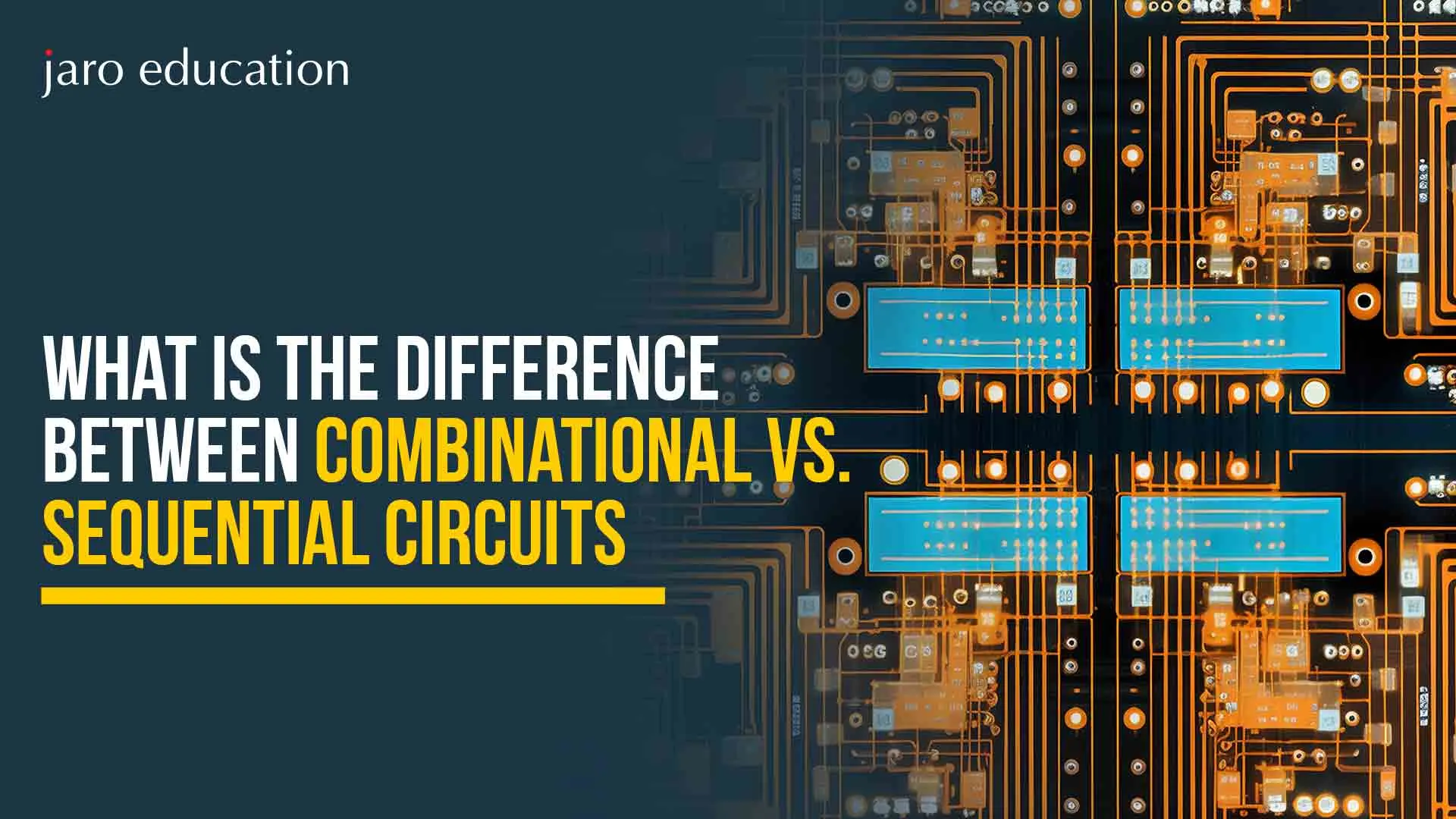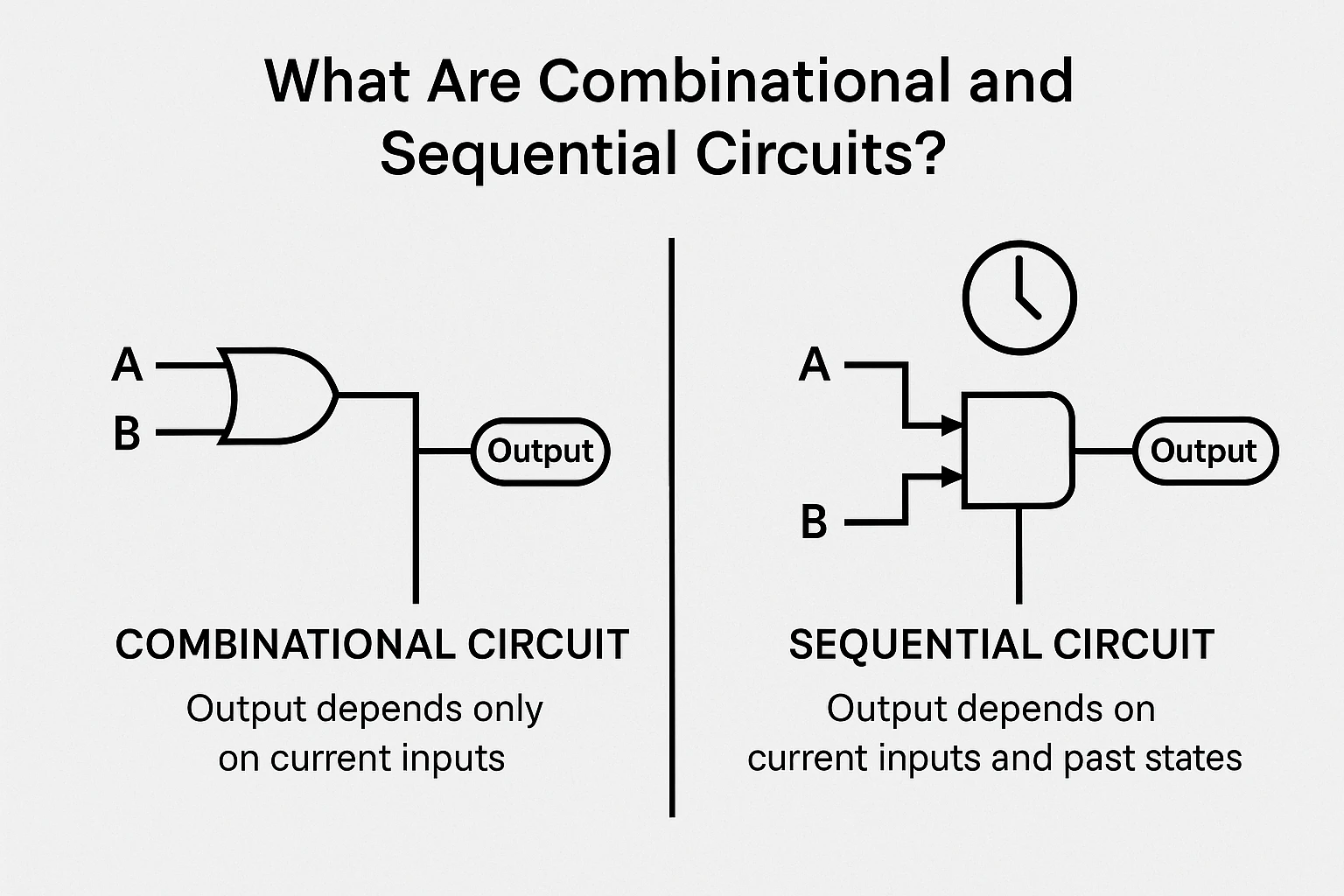What is the Difference Between Combinational Vs. Sequential Circuits
Table of Contents

- jaro Education
- 2, October 2024
- 10:00 am
Have you ever wondered how your calculator displays the results immediately or how a traffic signal changes at the right time? The magician behind the scenes is none other than two mighty kinds of digital circuits: the difference between combinational and sequential circuits. They are the bricks of modern electronics, and they silently perform the math, decisions, and control in everything, including gadgets up to industrial machinery.
In this blog, we are going to separate what the combinational vs Sequential Circuits are, discuss their functioning, and, most importantly, make you see the difference between combinational and sequential circuits. We will make it accessible, personal, and uncomplicated, regardless of whether you are an inquisitive student, an aspiring engineer, or simply someone who wants to know how digital systems work.
Now, let’s delve into the fascinating realm of combinational vs sequential circuits and compare them side-by-side to understand their impact on the technology we use every day.
Let’s unlock the secrets behind these two vital building blocks of digital systems!
What Are Combinational and Sequential Circuits?

When working with digital electronics, you’ll frequently come across two types of circuits: combinational circuits vs sequential circuits. Both serve different purposes, and understanding how they work can help you design and troubleshoot digital systems more effectively.
What is a Combinational Circuits?
Combinational circuits are the simpler of the two. In these circuits, the output is entirely determined by the current inputs. There’s no memory involved—once the inputs are set, the circuit immediately generates the output based on those inputs.
Key Features of Combinational Circuits
- No memory required: These circuits don’t “remember” past inputs; they work in real-time based only on the present input.
- Fast and straightforward: The output is calculated instantly as soon as the input changes.
- Made up of logic gates: Combinational vs Sequential Circuits are primarily built using logic gates like AND, OR, and NOT.
- Example: A multiplexer is a good example of a combinational circuit. It selects one of many input signals based on a selection input. Other examples include encoders, decoders, and simple arithmetic circuits.
What is a Sequential Circuit?
Unlike combinational circuits, sequential circuits are more complex because they take both the current inputs and previous states into account. In other words, they have memory. Having memory allows them to store information and use it later to influence the output, making them dependent on time or sequences of events.
Key Features of Sequential Circuits
- Memory-based: Sequential circuits can store past inputs and use this information along with current inputs to determine the output.
- Time-dependent: They often work in sync with a clock signal, which controls when the circuit updates its state.
- Built with flip-flops: The basic building blocks of digital electronics, sequential circuits are flip-flops, which are used to store data.
- Example: A counter is a classic example of a sequential circuit. It keeps track of how many clock pulses have occurred and stores its current state. Other examples include shift registers and memory elements used in computers.
Compare Combinational and Sequential Circuits Based on Memory
- Combinational Circuits: These circuits are quick and don’t rely on any memory—they simply generate the output based on the current input.
- Sequential Circuits: These circuits are slower but more powerful in many ways because they can “remember” past inputs and use them to influence future outputs.
By understanding the differences between these two types of circuits, you can better determine which one to use for your specific project or problem.
How Combinational Circuits Work (with Example)
Let’s take a half-adder—a basic combinational vs Sequential circuit used in computers to add binary numbers.
Inputs: A and B
Outputs:
Sum = A XOR B
Carry = A AND B
This is pure logic—no memory needed. You put in A and B, and it immediately tells you the sum and if there’s a carry.
How Sequential Circuits Work (with Example)
Take a D Flip-Flop, a common memory device.
It captures the input value at a specific moment (clock pulse) and remembers it until the next clock cycle. It’s like taking a snapshot.
Working:
Input D = value to remember
Clock = when to remember
Output Q = remembered value
So even if D changes later, Q will stay the same until the clock ticks again.
Difference Between Combinational and Sequential Circuits
When it comes to digital electronics, one of the most fundamental distinctions you need to understand is the difference between combinational and sequential circuits. These two types of circuits handle data and inputs in very different ways, and knowing how they operate can help you decide which one to use in various applications.
| Factors | Combinational Circuits | Sequential Circuits |
|---|---|---|
| Input Dependency | The output is determined solely by the current inputs. As soon as you provide input, the circuit processes it and immediately generates the corresponding output. | The output depends on both current inputs and previous inputs. These circuits “remember” past inputs, making their output based on both the present and past states. |
| Memory Element | These circuits do not have any memory. They process inputs in real-time without storing any previous states or data. | These circuits include memory elements, such as flip-flops, which allow them to store information from past inputs and use it to affect future outputs. |
| Speed of Operation | Since they don’t have to wait for past inputs or clock cycles, combinational circuits are generally faster. | These circuits operate more slowly because they rely on memory and clock signals to store and process past data. |
| Feedback Mechanism | There is no feedback loop in combinational circuits. The output is purely a function of the input, with no signal returning to influence future inputs. | These circuits have a feedback mechanism where part of the output is sent back as input. This feedback loop allows the circuit to retain its state and affect future outputs. |
| Complexity of Design | These circuits are simpler to design and implement because they only require logic gates to function. Since they don’t involve memory or feedback, the design is straightforward. | Sequential circuits are more complex because they involve memory elements and require careful synchronization with clock signals. This complexity allows for more advanced operations like counting, storing data, and controlling sequences. |
What are the Applications?

Combinational Circuits: Best suited for tasks that require immediate outputs based on current inputs. Common uses include arithmetic operations, data multiplexing, and code conversion.
Examples:
- Multiplexers
- Encoders and Decoders
- Arithmetic Logic Units (ALUs)
Sequential Circuits: Used in applications where past inputs must be stored or where outputs depend on sequences of events. These are essential in memory devices and control systems.
Examples:
- Counters
- Flip-flops
- Shift Registers
Mastering Digital Electronics: Combinational and Sequential Circuits
Differences between Combinational and sequential circuits are key elements in digital electronics, with combinational circuits generating outputs based on current inputs and sequential circuits using both current and past inputs by storing data. Understanding these circuits is vital for designing everything from logic gates to complex digital systems.
To master these concepts, a strong foundation in digital electronics is essential, particularly for professionals in fields like circuit design and embedded systems. The right education not only covers the theory but also equips you with practical skills to implement advanced systems.
What Jaro Education Offers
Jaro Education offers the Certificate Programme in Digital VLSI Design by CEP, IIT Delhi, providing in-depth knowledge of digital design, synthesis, and verification. This program prepares professionals to excel in the field of digital electronics and master the intricacies of the Difference between combinational and sequential circuits.
Conclusion: Which Circuit to Choose
Difference between combinational and sequential circuits depends on the specific requirements of your project:
If you need a quick, time-independent system where output is based on current inputs, then combinational circuits are ideal.
On the other hand, if you require a system where past inputs affect the current output, or you need to store data over time, then sequential circuits are the right choice.
Both circuits are integral to digital electronics and play crucial roles in the design of complex systems. By understanding their differences, you can better decide which to use for your specific application.
Frequently Asked Questions
Combinational circuits produce outputs based solely on current inputs. Sequential circuits, on the other hand, produce outputs based on current inputs and stored past inputs, using memory elements like flip-flops.
A combinational circuit is a digital logic circuit where the output is a direct function of the current input values only, with no memory involved. Examples include adders, encoders, decoders, and multiplexers.
A sequential circuit is a digital logic circuit that uses memory elements to store past input information. Its output depends on both the current input and the previous states. Common examples include flip-flops, counters, and registers.
No, combinational circuits cannot store data. They have no memory components and provide output only based on current inputs.
Sequential circuits use a clock signal to synchronize changes in output and memory states. The clock ensures that data is stored and processed in a controlled, timed manner.


![Salary-of-BCA-Graduates-Top-Job-Roles-[2025]](https://jaro-website.s3.ap-south-1.amazonaws.com/2025/10/Salary-of-BCA-Graduates-Top-Job-Roles-2025-1024x576.webp)






